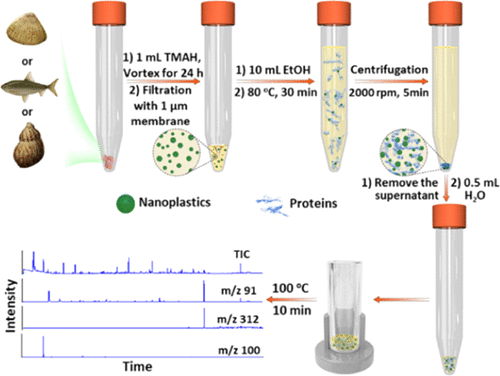当前位置:
X-MOL 学术
›
Environ. Sci. Technol.
›
论文详情
Our official English website, www.x-mol.net, welcomes your feedback! (Note: you will need to create a separate account there.)
Quantitative Analysis of Polystyrene and Poly(methyl methacrylate) Nanoplastics in Tissues of Aquatic Animals
Environmental Science & Technology ( IF 11.4 ) Pub Date : 2021-02-18 , DOI: 10.1021/acs.est.0c08374 Xiao-Xia Zhou 1 , Shuai He 1 , Yan Gao 1, 2 , Hai-Yuan Chi 1 , Du-Jia Wang 1, 2 , Ze-Chen Li 1 , Bing Yan 1, 2
Environmental Science & Technology ( IF 11.4 ) Pub Date : 2021-02-18 , DOI: 10.1021/acs.est.0c08374 Xiao-Xia Zhou 1 , Shuai He 1 , Yan Gao 1, 2 , Hai-Yuan Chi 1 , Du-Jia Wang 1, 2 , Ze-Chen Li 1 , Bing Yan 1, 2
Affiliation

|
Micro- and nanoplastics unavoidably enter into organisms and humans as a result of widespread exposures through drinking waters, foods, and even inhalation. However, owing to the limited availability of quantitative analytical methods, the effect of nanoplastics inside animal bodies is poorly understood. Herein, we report a sensitive and robust method to determine the chemical composition, mass concentration, and size distribution of nanoplastics in biological matrices. This breakthrough is based on a novel procedure including alkaline digestion and protein precipitation to extract nanoplastics from tissues of aquatic animals, followed by quantitative analysis with pyrolysis gas chromatography–mass spectrometry. The optimized procedure exhibited good reproducibility and high sensitivity with the respective detection limits of 0.03 μg/g for polystyrene (PS) nanoplastics and 0.09 μg/g poly(methyl methacrylate) (PMMA) nanoplastics. This method also preserved the original morphology and size of nanoplastics. Furthermore, to demonstrate the feasibility of the proposed method, 14 species of aquatic animals were collected, and PS nanoplastics in a concentration range of 0.093–0.785 μg/g were detected in three of these animals. Recovery rates of 73.0–89.1% were further obtained for PS and PMMA nanospheres when they were spiked into the tissues of Zebra snail and Corbicula fluminea at levels of 1.84–2.12 μg/g. Consequently, this method provides a powerful tool for tracking nanoplastics in animals.
中文翻译:

水生动物组织中聚苯乙烯和聚甲基丙烯酸甲酯纳米塑料的定量分析
由于饮用水,食物甚至吸入物的广泛接触,微米和纳米塑料不可避免地进入了生物和人类。但是,由于定量分析方法的可用性有限,人们对动物体内纳米塑料的作用了解甚少。在这里,我们报告了一种灵敏而健壮的方法来确定生物基质中纳米塑料的化学组成,质量浓度和尺寸分布。这一突破是基于一种新颖的程序,包括碱消化和蛋白质沉淀从水生动物组织中提取纳米塑料,然后用热解气相色谱-质谱法进行定量分析。优化的程序具有良好的重现性和高灵敏度,各自的检测限为0。聚苯乙烯(PS)纳米塑料为03μg/ g,聚甲基丙烯酸甲酯(PMMA)纳米塑料为0.09μg/ g。该方法还保留了纳米塑料的原始形态和尺寸。此外,为证明该方法的可行性,收集了14种水生动物,其中三只动物检出PS纳米塑料的浓度范围为0.093-0.785μg/ g。当将PS和PMMA纳米球刺入组织中时,它们的回收率进一步达到73.0-89.1%。在其中三只动物中检测到785μg/ g。当将PS和PMMA纳米球刺入组织中时,它们的回收率进一步达到73.0-89.1%。在其中三只动物中检测到785μg/ g。当将PS和PMMA纳米球刺入组织中时,它们的回收率进一步达到73.0-89.1%。斑马蜗牛和大戟(Corbicula fluminea)的含量为1.84-2.12μg/ g。因此,该方法为跟踪动物中的纳米塑料提供了强大的工具。
更新日期:2021-03-02
中文翻译:

水生动物组织中聚苯乙烯和聚甲基丙烯酸甲酯纳米塑料的定量分析
由于饮用水,食物甚至吸入物的广泛接触,微米和纳米塑料不可避免地进入了生物和人类。但是,由于定量分析方法的可用性有限,人们对动物体内纳米塑料的作用了解甚少。在这里,我们报告了一种灵敏而健壮的方法来确定生物基质中纳米塑料的化学组成,质量浓度和尺寸分布。这一突破是基于一种新颖的程序,包括碱消化和蛋白质沉淀从水生动物组织中提取纳米塑料,然后用热解气相色谱-质谱法进行定量分析。优化的程序具有良好的重现性和高灵敏度,各自的检测限为0。聚苯乙烯(PS)纳米塑料为03μg/ g,聚甲基丙烯酸甲酯(PMMA)纳米塑料为0.09μg/ g。该方法还保留了纳米塑料的原始形态和尺寸。此外,为证明该方法的可行性,收集了14种水生动物,其中三只动物检出PS纳米塑料的浓度范围为0.093-0.785μg/ g。当将PS和PMMA纳米球刺入组织中时,它们的回收率进一步达到73.0-89.1%。在其中三只动物中检测到785μg/ g。当将PS和PMMA纳米球刺入组织中时,它们的回收率进一步达到73.0-89.1%。在其中三只动物中检测到785μg/ g。当将PS和PMMA纳米球刺入组织中时,它们的回收率进一步达到73.0-89.1%。斑马蜗牛和大戟(Corbicula fluminea)的含量为1.84-2.12μg/ g。因此,该方法为跟踪动物中的纳米塑料提供了强大的工具。



























 京公网安备 11010802027423号
京公网安备 11010802027423号